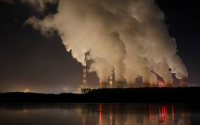24 November 2008
When global warming enters the realm of politics, the conversation usually focuses on a few "solutions" — a bill capping carbon dioxide, "clean coal," a climate treaty (you've read a lot here on "clean coal"; a lot more on treaties is coming shortly).
Joe Romm, an energy specialist, climate campaigner and blogger (and someone who has taken issue with my characterization of the climate challenge), has been trying to lay out the hard reality of what it would really take to cut carbon dioxide emissions as humanity grows and continues trying to prosper. After James E. Hansen of NASA posted his latest prescription for energy policies to limit climate risks, Mr. Romm posted an open letter to Dr. Hansen saying why he feels the NASA climate scientist has the science right, but the energy strategy wrong.
Among other points, Mr. Romm says the "fourth generation" form of nuclear power discussed by Dr. Hansen has no greater potential benefits than other technologies (solar-thermal power plants, for example) that were not mentioned but that could be deployed at large scale much more quickly.
He also rejects Dr. Hansen's push for a tax instead of a cap to drive down emissions of greenhouse gases, but at the same time acknowledges that cap-and-trade legislation limiting emissions — widely portrayed by politicians as the prime point of debate — is not Step 1, but part of a long-term strategy. Keep that in mind as the Congressional debate begins.
There's a lot more in Mr. Romm's Sunday post and the string of earlier pieces he links to. Here's a follow-up e-chat I had with him last night to amplify on a few points. My four questions are followed by his answers.
1. You seem to say that if folks change the message (better journalism; better, more informed leaders), the public will then buy the higher costs and changes that are now politically untenable. Do you really believe that or am I misreading?
2. As I wrote in 2006 ("Yelling Fire on a Hot Planet") problems that get people's attention (and cause them to change) are "soon, salient and certain" and the dangerous aspects of human-forced climate disruption remain none of those things. The factors that matter most to society are the least certain, like the overall sensitivity of climate to rising CO2, the rate of sea level rise by 2100, even as the long-term picture remains clear (as I've written for ages). As Sir Nicholas Stern put it, "The sting is in the tail." Gary Yohe at Yale says uncertainty, not what is known, is the reason to act. Is your own definition of urgency a function of what's known, or what's possible?
3. You call global warming urgent and call Barack Obama's climate plan "extraordinary." (By the way, when you predict conservatives will torpedo it, are you including Democrats from fossil states?) But with Mr. Obama's much-repeated $15 billion per year for advanced clean energy contingent on cap-and-trade auction revenues that may not come for years, do you see that as conveying adequate urgency?
4. Can you point me to your best explanation for how a politically feasible cap-and-trade bill — even one crafted by a relatively climate-friendly Congress — will have any impact at all on emissions sufficient for the atmosphere to notice by midcentury or so? (This is particularly important given that the financial mess may have reduced taxpayers' confidence in any trading system involving billions of dollars and something as hard to weigh as tons of carbon dioxide.)
From Joe Romm:
On the science If people understood what Hansen has been explaining, what the IPCC report says if you read it closely, what climate scientists say off the record, what I try to cull together from the literature, they would understand that we can't go above 450 p.p.m. [parts per million of CO2 in the atmosphere], because that will almost certainly take us across thresholds that shoot to 750 to 1000 p.p.m. — and that is 5°C+ warming, and that is an ice-free planet. You and I have talked about this briefly sometimes. In particular, if carbon in the tundra and the peatlands start to go in a serious fashion, especially as methane, then it is game over.
On scientists a) Few understand energy, so they only understand one half of the grim equation. Only people like Hansen, who have taken the time to educate themselves on energy understand how dire things really are. b) They refuse to internalize the fact that the world isn't listening to them, so they keep running all these models of 450 p.p.m. and 550 p.p.m. and 650 p.p.m. that create this absurdly false range of future impacts. And this leaves policy makers with the notion that scientists don't know with precision what's going to happen.
There isn't any uncertainty about what happens if we keep doing nothing or very little. The people who are peddling the uncertainty myth are internalizing the notion that politicians are going to start deploying multiple wedges starting almost immediately. ["Wedges" comes from an assessment by two Princeton scientists of ways to get big CO2 emission reductions from particular sectors, like transportation and efficiency (see our 2006 graphic explaining some emission wedges). Mr. Romm's posts provide good background on this thought experiment.]
This may well be my biggest disagreement with you. You understand this but you don't convey this to your readers: Doing nothing or doing little eliminates the uncertainty.
On what drives action and what kind of leaders we need This post [on lessons from the financial bailout] lays out my thinking:
Multi-hundred-billion-dollar-sized government action happens only when there is a very, very big crisis…. A necessary, but not sufficient, condition for a crisis to be "very, very big" is that it must be labeled as such by very serious people who are perceived as essentially nonpartisan opinion leaders…. In addition, bad things must be happening to regular people right now…. The credible people must say that the government action is going to solve the problem.
Then I say how this applies to climate.
Better journalism would help. You perhaps saw my article criticizing the NYT on the bark beetle story.
We simply don't have a critical mass of credible nonpartisan opinion leaders who understand the nature of our energy and climate problem.
On Obama What we most need now is an educator and persuader in chief. That we have. Can he start doing a half-dozen wedges? No. But can he create the technological means and public knowledge needed so that the next president can when things start really going bad? Yes.
We will need a WWII-style approach, but that can only happen after we get the global warming Pearl Harbor or, more likely, multiple Pearl Harbors. The crucial thing is that we need to be ready when that happens both technologically and politically. That will take 5 to 10 years — and not because we need breakthroughs, but because we need to see some significant penetration of things like CSP and plug-ins [CSP is concentrated solar power, or arrays of mirrors that generate heat to drive a generator; "plug ins" refers to plug-in hybrid vehicles.] so they can be really ramped up.
For me, 2015 is the target year. If you have any cost-effective, scalable low carbon technology then, that's what we'll go with. Obama will launch the $15 billion a year in 2009. I suspect the first two years will be part of the stimulus — which I expect will have many more tens of billions of dollars in it for clean energy. Future years can be forward borrowed until the cap kicks in.
On cap and trade legislation I don't see that as the first strategy anymore, as I said in my Nature Online article. The latest science suggests that national and global climate policy is seriously misdirected. We must aim at achieving average annual carbon dioxide emissions of less than 5 GtC [5 billion metric tons of carbon] this century or risk the catastrophe of reaching atmospheric concentrations of 1,000 p.p.m.
A carbon price set by a cap-and-trade system is a useful component of a longer-term climate strategy. Implementing such a system, however, is secondary to adopting a national and global strategy to stop building new traditional coal-fired plants while starting to deploy existing and near-term low-carbon technologies as fast as is humanly possible.
So we need to stop new coal now. Ramp up spending on technology deployment now. Shift state regulations to put energy efficiency on an at least an equal footing as supply. Meanwhile, we enact a hard cap without many offsets.
One final point — those "impossible" eight wedges I laid out probably represent a switch in investment of 2% to 3% of global GDP if done in two decades, half that if done in four decades (as the I.E.A. analysis shows). That is a fantastic quantity of money in absolute terms but a very small fraction of our wealth. Plus you get back a lot of the money in energy savings.
That's why I.E.A. and I.P.C.C. and McKinsey find that 450 p.p.m. only slows GDP maybe 0.1% per year. MONEY isn't the problem. Time and political will are the problem.
There are a few important points above that I'll be writing on — and asking Mr. Romm about — in coming weeks, months (and, yes, probably years).
Perhaps the most important one comes where Mr. Romm — echoing others, including Paul Hawken here — says that meaningful climate policy, even with leadership and effective communication, still requires another element: "Bad things must be happening to regular people right now…."
As I wrote in our "Climate Divide" package, however, wealthy countries are already using wealth and technology to shield themselves from the hazards that attend climate extremes even as poor countries in the South are most apt to get hammered. What kind of wake-up call does Mr. Romm think is conceivable on a time scale relevant to near-term policy? [UPDATE 12:30 p.m. - His answer is below.]
Lacking that element (and my sense is that nature may well exhibit more than enough variability for years to mask potential "Pearl Harbor" moments), does Mr. Romm see his game plan holding up? That's why I've been asking, "Can Climate Campaigns Withstand a Cooling Test?" and "Are Words Worthless in the Climate Fight?"
I'll also keep examining arguments for an "energy quest" in which cutting climate risks is one component, and a greatly intensified, sustained research enterprise focused on energy frontiers is also a top priority. Look at the graph in my post on what an "energy moon shot" would look like to see the effort and investment that went into the Apollo program and the war on cancer. Compare those efforts to our public investment in pursuing energy advances. And don't think the private sector is filling the gap. (Click here to see the long-term drop in private energy R.&D.)
Joe Romm's answer to the question above on near-term "Pearl Harbors":
Mutliple Pearl Harbors over the next decade — half or more of these happening:
1) Arctic goes ice free before 2020. I have bets out on this. It would be a big, visible global shock. 2) Rapid warming over next decade, as recent Nature and Science article suggests is quite possible (posts here and here) 3) Continued (unexpected) surge in methane 4) A megadrought hitting the SW comparable to what has hit southern Australia. 5) More superstorms, like Katrina 6) A heatwave as bad as Europe's 2003 one. 7) Something unpredicted but clearly linked to climate, like the bark beetle devastation. 8) Accelerated mass loss in Greenland and/or Antarctica, perhaps with another huge ice shelf breaking off, but in any case coupled with another measurable rise in the rate of sea level rise, 9) The Fifth Assessment Report (2012-2013) really spelling out what we face with no punches pulled.






